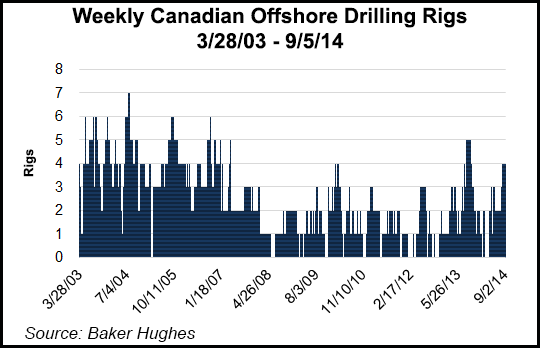Regulatory | NGI All News Access
Canada’s NEB Gives Would-Be Offshore Drillers a Break
Arctic gas and oil hunters have been spared having to conduct environmental assessments twice on their plans to return to Canadian waters of the Beaufort Sea.

The National Energy Board (NEB), postponing complete examinations demanded by wary environmentalists, has ruled that the first stage in reviewing plans by Imperial Oil, ExxonMobil, BP and Chevron Canada will focus tightly on a technical issue.
The question will be whether current well-control hardware and drilling safety manuals add up to substitutes for a requirement imposed on previous generations of northern frontier drilling: same-season relief well capability, or SSRW for short. The NEB defined the issue after lengthy debate on the scope of the first step in regulatory scrutiny of the exploration revival, which included environmental groups such as the Natural Resources Defense Council, World Wildlife Fund and Sierra Club.
The board acknowledged that the New York City-based council, especially, sought a review that would make rules for exactly how to judge whether new industry blowout prevention and control systems minimize environmental harm.
Granting the request would “require collection of all data relevant for understanding the impacts of a spill as well as the establishment of an environmental baseline against which spill impacts can be measured,” said the board ruling. The stage-one review will only aim to achieve “a high-level objective” that concentrates on engineering and safety standards for “ensuring, to the extent possible, that a multi-year well blowout will not occur,” said the NEB.
“Minimizing harmful impacts with an SSRW is achieved by stopping the flow of hydrocarbons into the environment. SSRW capability does not minimize environmental effects in any other way.”
The board promised that next-stage reviews of the gas and oil hunters’ fully developed exploration projects will include examination of harm liable to be done by spills on the scale that the preliminary SSRW inquiry will establish.
The ruling was far from a complete defeat for the environmental agencies.
The NEB ordered the companies to articulate “worst-case scenarios” for failures of their proposed next-generation arctic technology and worker safety codes, saying how big and long any spills are liable to be. Assessing risks of big failures will obviously become part of the SSRW review, added the board.
The NEB added a northern Canadian wrinkle to the review of the proposed Beaufort exploration revival: examination of how industry operations are affected by arctic conditions such as cold, sea ice, brief summer work periods and darkness as daylight hours contract towards zero between warm seasons.
As leaders of two planned arctic offshore drilling expeditions, Imperial and Chevron have told the NEB and Mackenzie Delta aboriginal regulatory agencies that deepwater Beaufort well applications would be a waste of time — and will not be made — unless they are allowed to use SSRW substitutes. The old requirement would be impossible to fulfill in the remote target areas, the companies said.
None of the companies have disclosed long-range production plans. But wary native communities and environmentalists say global warming is melting the arctic ice enough for industry to consider sailing tankers through the Northwest Passage.
The proposed Beaufort exploration revival arises from plans to satisfy work requirements on offshore leases that the companies bought from Canada’s federal government.
Information on the drilling targets is highly confidential. But sketchy outlines of work scheduled to start by 2020 center on prospects 125 kilometers (75 miles) or more from the Beaufort coast in water up to 1,500 meters (4,920 feet) deep.
Northern deepwater drilling proposals predict sea-ice conditions will be “manageable” by current state-of-the-art equipment for 120-day summer work seasons. The new Beaufort expeditions draw on a Canadian art known as ice management, which was developed during 1970s and ’80s offshore gas and oil hunting programs.
In the deep-water Beaufort drilling area, air temperatures average 10 degrees C (50 degrees F) during the warm months and the ocean heats up just enough to help break up the arctic ice pack. Beaufort winters average minus 27 degrees C (minus 17 degrees F). Seawater congeals into mobile floes of variable thickness formed by complex interactions of winds, currents and waves.
Despite global warming forecasts, icebreaker vessels remain a Beaufort must. Much drifting ice survives through the summer and forms roving packs that obstruct ocean traffic and exert tremendous force if they hit beaches or collide with ships and work platforms.
© 2024 Natural Gas Intelligence. All rights reserved.
ISSN © 1532-1231 | ISSN © 2577-9877 |
